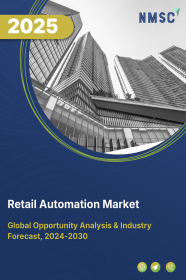
Retail Automation Market by Type (Point-of-Sale (POS) Systems, Automated Identification Systems, Electronic Shelf Labels (ESLS), Cameras, Robots, Autonomous Guided Vehicle, Automated Storage and Retrieval Systems (AS/RS), Conveyor & Sortation Systems), by Implementation (In-store and Warehouse), by End User (Hypermarkets, Supermarkets, Retail Stores, Specialty Stores, and Other End Users) - Global Opportunity Analysis and Industry Forecast, 2021 – 2030
Industry: ICT & Media | Publish Date: 13-Mar-2025 | No of Pages: 370 | No. of Tables: 265 | No. of Figures: 210 | Format: PDF | Report Code : IC320
Market Overview:
The global Retail Automation Market size was valued at USD 11.26 billion in 2020 and is predicted to reach USD 33.02 billion by 2030, with a CAGR of 11.67% from 2021-2030.
Retail automation is the amalgamation of technologies deployed to semi-automate or fully-automate the retail stores or warehouses, benefitting the retailers with increased operational efficacy, reduced errors, quick & easy access, higher precisions, minimal human intervention, and consequently decreased labor cost.
Autonomous Guided Vehicle (AGV), Autonomous Mobile Robotics (AMR), automated retail kiosks, self-vending machines, online distribution channels, and other retail automations are gaining momentum in-stores as well as in warehousing, hence proliferating the growth of global market.
Market Dynamics and Trends
Approximately 1.8 billion people purchased goods online amounting to $2.8 trillion in the year 2018 and this figure is expected to elevate up-to $4.8 trillion by 2021. This trend is expected to create new avenues for the growth in the global retail automation market in coming future.
Furthermore, increase in demand for merchandise optimization, higher adoption of AI, IoT, API, and robotics technologies, emerging concept of Logistic warehousing, growing trend of e-commerce & m-commerce retails, advancements in real-time data analytics, as well as evolution of virtual marketing, are the factors driving the growth of global market. However, higher installation and maintenance cost, and lack of awareness regarding retail automations in the budding economies, are expected to impede the retail automation market growth during the forecast period.
Moreover, advancements in product technologies, schemes offered by online-retailers to attract consumers, increasing purchasing power of consumers, modernization of infrastructures, and untapped market opportunities offered by emerging economies, are anticipated to supplement the growth of the market in coming future.
Market Segmentations and Scope of the Study:
The global retail automation market share has been analyzed based on type, implementation, end user and geography. Based on type, the retail automation market report is segmented into Barcode & RFID, Point-of-Sale (POS), Camera, Electronic Shelf Label (ESL), Autonomous Guided Vehicle (AGV), and others. Based on implementation, the market is fragmented in-store and warehouse. Based on end user, the market is divided into hypermarkets, supermarkets, single item stores, fuel stations, and retail pharmacies. Geographic breakdown and analysis of each of the previously mentioned segments include regions comprising North America, Europe, Asia-Pacific, and RoW.
Geographical Analysis
North America dominated the global retail automation market share in the past, and is expected to maintain its dominance throughout the forecast period, owing to well-established retail infrastructures, presence of key manufactures, and a large consumer base.
Asia Pacific is expected to show rapid growth in the global market with substantial market share, owing to increase in per-capita disposable income, changing consumer preferences, increase in digital transformations, and technological evolution.
Competitive Landscape
The retail automation industry, which is highly competitive, consists of various market players. Some of the major market players include Honeywell International Inc., NCR Voyix Corporation, Diebold Nixdorf, Incorporated, Zebra Technologies Corp., Hangzhou Hikvision Digital Technology Co., Ltd., NXP Semiconductors, Dahua Technology Co., Ltd, Daifuku Co., Ltd., Kion Group AG, AVERY DENNISON CORPORATION, Datalogic S.p.A., Fujitsu Limited, Fiserv, Inc., Posiflex Technology Inc., Bosch System GmbH among others. The key players are employing strategies such as product launches, acquisition, and technical collaboration, in-order to gain stronger position in the global market.
For instance, in January 2020, Toshiba Global Commerce Solutions, a subsidiary of Toshiba Corporation, and one of the major players in the market, announced that it is helping Weis Markets to improve its customer experience. Toshiba offers a number of cash & cashless payment solutions, based on highly advanced self-service technology, thereby offering faster checkouts along with maximizing the utilization of each lane.
In January 2020, NCR corporation, one of the leading firms in the global market, announced that BevMo, the specialty beverage retailer has selected NCR Emerald for driving its digital transformation, hence promoting a consistent customer experience across physical and digital channels. NCR Emerald shall run BevMo’s store operations like integrated payments, loyalty & promotions, merchandising, and self-service for consumers.
In March 2020, Fiserv, Inc., a global provider of financial services in the market, announced its acquisition over Bypass Mobile, an independent software vendor and pioneer innovator in enterprise point-of-sale systems. Fiserv aims at enhancing its omni-commerce capabilities, with Bypass providing its rich insight engines and robust back office management tools for national restaurant chains, sports & entertainment venues, and others. This acquisition shall lead Fiserv to deliver smooth customer experience spanning the physical and digital channels.
Key Benefits
-
The retail automation market report provides the quantitative analysis of the current market and estimations through 2020-2030 that assists in identifying the prevailing market opportunities to capitalize on.
-
The study comprises a deep dive analysis of the retail automation market trend including the current and future trends for depicting the prevalent investment pockets in the market.
-
The report provides detailed information related to key drivers, restraints and opportunities and their impact on the global market.
-
The report incorporates competitive analysis of the market players along with their market share in the global market.
-
The SWOT analysis and Porters Five Forces model is elaborated in the study of the market.
-
Value chain analysis in the market study provides a clear picture of the stakeholders’ roles.
Retail Automation Market Key Segments
By Type
-
Point-of-Sale (POS) Systems
-
Interactive Kiosks
-
Self-Checkout Systems
-
-
Automated Identification Systems
-
RFID Systems
-
RFID Readers
-
RFID Tags
-
-
Barcode Readers
-
-
Electronic Shelf Labels (ESLS)
-
LCDs
-
Segmented E-Paper Displays
-
Fully Graphic E-Paper Displays
-
-
Cameras
-
Robots
-
Autonomous Mobile Robots (AMRs)
-
Collaborative Robots (COBOTS)
-
-
Automated Guided Vehicles
-
Automated Strorage and Retrieval Systems (AS/RS)
-
Conveyor & Sortation Systems
By Implementation
-
In-store
-
Warehouse
By End User
-
Hypermarkets
-
Supermarkets
-
Retail Stores
-
Specialty Stores
-
Other End Users
By Geography
-
North America
-
U.S
-
Canada
-
Mexico
-
-
Europe
-
UK
-
Germany
-
France
-
Spain
-
Italy
-
Netherlands
-
Denmark
-
Finland
-
Norway
-
Sweden
-
Russia
-
Rest of Europe
-
-
Asia-Pacific
-
China
-
Japan
-
India
-
Australia
-
South Korea
-
Thailand
-
Singapore
-
Rest of Asia-Pacific
-
-
RoW
-
Latin America
-
Middle East
-
Africa
-
Key Players:
-
Honeywell International Inc.
-
NCR Voyix Corporation
-
Diebold Nixdorf, Incorporated
-
Zebra Technologies Corp.
-
Hangzhou Hikvision Digital Technology Co., Ltd.
-
NXP Semiconductors
-
Dahua Technology Co., Ltd
-
Daifuku Co., Ltd.
-
Kion Group AG
-
AVERY DENNISON CORPORATION
-
Datalogic S.p.A.
-
Fujitsu Limited
-
Fiserv, Inc.
-
Posiflex Technology Inc.
-
Bosch System GmbH
Report Scope and Segmentation
|
Parameters |
Details |
|
Analysis Period |
2020–2030 |
|
Base Year Considered |
2020 |
|
Forecast Period |
2021–2030 |
|
Market Size Estimation |
Billion (USD) |
|
Market Segmentation |
By Type (Point-of-Sale (POS) Systems, Automated Identification Systems, Electronic Shelf Labels (ESLS), Cameras, Robots, Autonomous Guided Vehicle, and Others), by Implementation (In-store and Warehouse), by End User (Hypermarkets, Supermarkets, Retail Stores, Specialty Stores, and Other End Users) |
|
Geographical Segmentation |
North America (U.S., Canada, Mexico) Europe (UK, Germany, France, Spain, Italy, Netherlands, Denmark, Finland, Norway, Sweden, Russia, Rest of Europe), Asia-Pacific (China, Japan, India, Australia, South Korea, Thailand, Singapore, Rest of Asia-Pacific), Rest of the World (Latin America, Middle East, Africa) |
|
Companies Profiled |
Honeywell International Inc., NCR Voyix Corporation, Diebold Nixdorf, Incorporated, Zebra Technologies Corp., Hangzhou Hikvision Digital Technology Co., Ltd., NXP Semiconductors, Dahua Technology Co., Ltd, Daifuku Co., Ltd., Kion Group AG, AVERY DENNISON CORPORATION, Datalogic S.p.A., Fujitsu Limited, Fiserv, Inc., Posiflex Technology Inc., Bosch System GmbH |

















 Speak to Our Analyst
Speak to Our Analyst




















